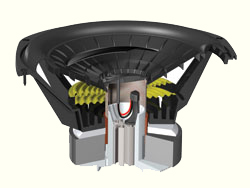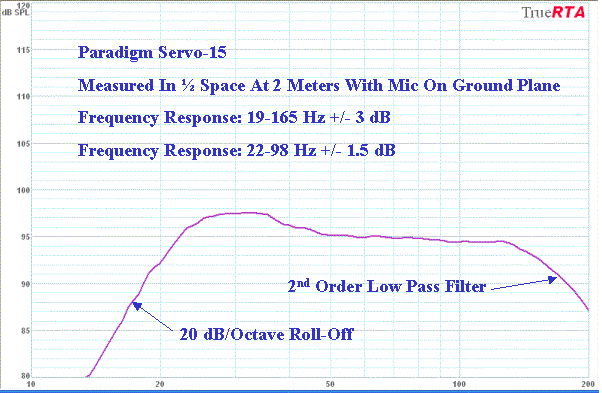Introduction
At CES 2005, I had the privilege of sharing dinner with the company reps
from Paradigm. Bill VanderMarel (U.S. Director of Sales & Marketing)
patiently answered all my questions about the Paradigm subwoofer line-up. I
was extremely impressed with his breadth and depth of knowledge regarding
all aspects of loudspeaker research and design.
We decided the Servo-15 V2 would be a good candidate for a review, and I set
up delivery with Mark Aling, Paradigm's Marketing Manager. I took delivery
directly from the local freightliner outlet. When a subwoofer comes loaded
on a pallet and requires a forklift to load into your truck, you know it's a
serious piece of audio equipment.
The Design
While the Servo-15 will never disappear in the room, it is certainly
manageable in size, measuring roughly 20” (H) x 18” (W) x 21” (D). It is
build like a proverbial tank, checking in at about 115 pounds, so two people
are recommended to move it.
Fit and finish are excellent, as expected with a subwoofer in this price
class. The cabinet on my review model is attractively finished in a satin
cherry veneer (other finishes are available). The cabinet geometry is
conventional, but the edges are nicely beveled. The interior of the cabinet
is lined with batting, and features extensive bracing, ensuring good
strength and rigidity. The amp is flush mounted and nicely fitted with no
raised edges.
There are four large hard-plastic feet on the bottom of the
cabinet. This floor interface solution will work well for any kind of
mounting surface, and the Servo-15 never vibrated or wandered on my hard
laminate flooring, even at high playback volumes.
 The grille is constructed of a lightweight composite fiberboard and is 1.25”
thick (required to clear the high excursion woofer). The front of the grille
frame is beveled and contoured, making it appear slimmer. The grille fabric
is conventional black knit, tightly stretched over the frame with no
loose threads, and has neat adhesive work. There are four plastic grille pins and
cabinet grommets. A translucent Paradigm Reference nameplate graces the
grille, and aligns with a blue light built into the cabinet. So, the nameplate
glows blue whenever the subwoofer is in operation.
The grille is constructed of a lightweight composite fiberboard and is 1.25”
thick (required to clear the high excursion woofer). The front of the grille
frame is beveled and contoured, making it appear slimmer. The grille fabric
is conventional black knit, tightly stretched over the frame with no
loose threads, and has neat adhesive work. There are four plastic grille pins and
cabinet grommets. A translucent Paradigm Reference nameplate graces the
grille, and aligns with a blue light built into the cabinet. So, the nameplate
glows blue whenever the subwoofer is in operation.
The Servo-15 is an acoustic suspension (sealed enclosure) design, with a front-firing 15”
woofer. This revised woofer (this is version 2) features a die cast aluminum basket, a 29 pound
magnet structure, an 8-layer 3” voice coil, a massive aluminum heat sink,
and dual heavy-duty spiders. The polypropylene cone features a large convex
dust cap, massive butyl surround, and special reinforcing ribbing to provide
additional stiffness and rigidity. Visually this woofer is a work of art; it
looks substantial, menacing, and refined all at once. Once you pull the
grille, you may never feel the need to replace it – this woofer looks that
good.
 The peak-to-peak linear excursion of the
driver is over 2 inches, providing
significant air displacement capability. In an acoustic suspension design,
to maintain a given sound pressure level, cone excursion must quadruple with
each successively lower octave, e.g., if the driver moves
± 0.5" at 40 Hz, it will have to move
± 2" at 20 Hz. So, providing high output and low distortion
in the 17 Hz -25 Hz region is extremely demanding on a sealed woofer alignment.
That is why the Servo-15 woofer has such a heavy-duty, long-throw woofer.
The peak-to-peak linear excursion of the
driver is over 2 inches, providing
significant air displacement capability. In an acoustic suspension design,
to maintain a given sound pressure level, cone excursion must quadruple with
each successively lower octave, e.g., if the driver moves
± 0.5" at 40 Hz, it will have to move
± 2" at 20 Hz. So, providing high output and low distortion
in the 17 Hz -25 Hz region is extremely demanding on a sealed woofer alignment.
That is why the Servo-15 woofer has such a heavy-duty, long-throw woofer.
Amplifier Details
- Class D; 1,250 watts continuous
- Off/On/Auto (3-way toggle switch)
- 12V Trigger (requires Off setting on the 3-way toggle)
- Low Level RCA Input
- Low Level XLR Balanced Input
- Low Pass Filter (35 Hz - 150 Hz continuously variable)
- High Pass Filter (est. 22 Hz, 1st order)
- Gain/Volume
- Phase Control (0-180 degrees continuously variable)
- Bass Contour (centered at 60 Hz, 0-6 dB)
- Soft Clipping, Thermal, and Electrical Short Protection
- Closed Loop Servo Feedback Correction
- Detachable Power Cord
 The control layout is logical
(photo at right), and the toggle switches and rotary knobs have
a quality feel and smooth operation. Several of the controls have pictograms
which can help the user understand the function. The 12 volt trigger and the
balanced XLR interconnect are nice pro-grade touches. The low-pass filter is
non-defeatable, so it should be set to 150 Hz if the user is relying on the
pre/pro for digital bass management. The auto-on circuit is very easy to
initialize at low volumes, and the Servo-15 comes alive with quirky pop
(which grew on me over time) and a glow of the blue light. If no signal is
present, there is a several minute shut-off delay.
The control layout is logical
(photo at right), and the toggle switches and rotary knobs have
a quality feel and smooth operation. Several of the controls have pictograms
which can help the user understand the function. The 12 volt trigger and the
balanced XLR interconnect are nice pro-grade touches. The low-pass filter is
non-defeatable, so it should be set to 150 Hz if the user is relying on the
pre/pro for digital bass management. The auto-on circuit is very easy to
initialize at low volumes, and the Servo-15 comes alive with quirky pop
(which grew on me over time) and a glow of the blue light. If no signal is
present, there is a several minute shut-off delay.
The closed-loop servo-feedback system works as follows: There is a solid
state
accelerometer chip attached to the woofer cone. The accelerometer senses
changes in velocity of the woofer cone and sends this information to a
sophisticated processor. This processor compares the cone motion to the
original input signal. Any discrepancy between the original input signal and
the cone motion means distortion is being created. If the processor detects
any discrepancies, it modifies the amplifier output signal to correct the
cone motion. This continuous servo-feedback loop (hence the name Servo-15)
ensures the woofer motion remains faithful to the input signal, keeping
distortion to a minimum.
The degree of control imposed by the servo circuit dictates the amount of
distortion the subwoofer is allowed to generate, which ultimately affects
output capability, particularly at the lowest frequencies. If the servo is
too strict, output linearity will suffer at the lowest frequencies. If the
servo is too lenient, distortion will become audible. The key to good
overall performance is to strike the proper balance.
On the Bench
Set-Up: All objective tests were conducted outside away from any reflective
structures, with the microphone on the ground plane, facing the subwoofer,
at a distance of 2 meters from the width and depth center point of the
cabinet. I set the low pass filter control to 150 Hz, and the phase control
to 00 (this resulted in a non-inverted impulse response). The Bass
Contour control was set to 00.
This test environment is often referred to as ½ space (2 pi steradians). An
anechoic chamber (or suspended in free space) would be considered full space
(4 pi steradians). Compared to full space, the ground plane adds 6 dB to the
test results, but otherwise does not affect the frequency response. So
testing a subwoofer in ½ space at 2 meters is equivalent (in both output and
frequency response) to testing it at 1 meter in an anechoic chamber.

Frequency Response: A short-duration (about 0.5 seconds), digitally
synthesized logarithmic sine sweep was used to evaluate the frequency
response of the subwoofer. The output of the sweep was adjusted for a 95 dB
average in the 50 Hz - 80 Hz region, and 1/6 octave smoothing was applied.
The Servo-15 frequency response measured 19 Hz - 165 Hz
± 3 dB. The frequency
response was exceptionally flat over most of the pass band, measuring 22 Hz - 98
Hz ± 1.5 dB.
A sealed alignment will roll-off naturally with a 12 dB/octave (2nd order)
slope. The Servo-15 roll-off measured 20 dB/octave (approximately 3rd
order), indicating the presence of a 1st order high pass filter at
approximately 22 Hz.
The effect of the non-defeatable low pass filter was also evident, with a
2nd order roll-off starting above 135 Hz (-2 dB at 150 Hz). Since almost
everyone uses digital bass management with an 80 Hz crossover, the lack of a
low-pass filter defeat switch is not significant, since the Servo-15
measured flat to well beyond 100 Hz.

Output Compression Testing: This test measures how loud the subwoofer can
play before its frequency response becomes non-linear. As the signal
strength is increased, all subwoofers will eventually show a reduction in
output at the lowest frequencies, and this phenomenon is known as
compression. Output compression can be caused by excessive heat in the
woofer voice coil, exceeding woofer excursion limits, or exceeding port flow
limits. It can also be caused by a servo circuit acting to reduce output in
order to maintain low distortion, or by amplifier limiter circuits engaging.
Output compression was evaluated with a 45 second logarithmic reverse sine
wave sweep
from 100 Hz - 10 Hz. Sweeps were conducted at progressively louder (2 dB
increments) levels, and the effects of compression were noted.
As shown below, the Servo-15 frequency response remained linear
(uncompressed) up to the green curve, showing a maximum of 99 dB at 20 Hz,
104 dB at 30 Hz, and 102 dB at 50 Hz. The next three higher sweeps (purple,
yellow, orange) show progressively more output compression occurring. Also
provided below is a graph showing the actual amount of output compression
(relative to the green curve) for the purple, yellow, and orange sweep
levels. 1/6 octave smoothing was applied to all curves.
According to Paradigm R&D, this compression is a result of reaching the
maximum excursion limits of the woofer, and not related to any thermal
issues with the voice coil. Paradigm states the 3” 8-layer voice coil is
virtually immune to thermal power compression.
Most subwoofers exhibit as least some audible distress during the
compression testing, but not the Servo-15. Even at extremely loud sweep
levels, the Servo-15 never whimpered, faltered, or emitted even a hint of
any audible artifacts. The amplifier became too hot to touch during this
torture test, and yet it never shut down and always functioned perfectly.
Hitting 99 dB @ 20 Hz @ 2 meters in ½ space before the onset of compression
is a very good performance for a sealed enclosure servo subwoofer. And despite some
compression occurring at the very deepest frequencies, the Servo-15 still
remained linear to 110 dB at 35 Hz at the highest sweep level, which is
quite impressive. Except at the very loudest playback levels, listeners can
expect a dynamic and uncompressed presentation from the Servo-15.


Click HERE to go to
Part II

